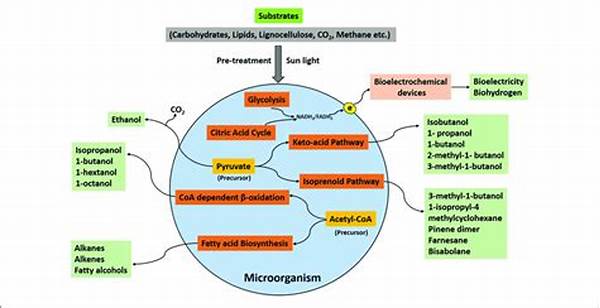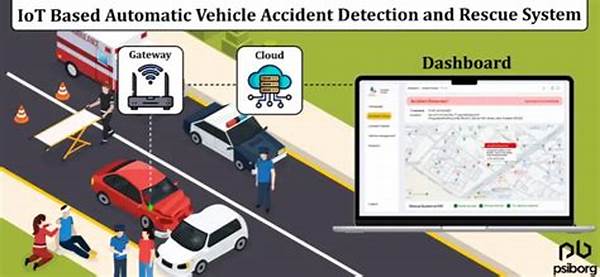Microbial Metabolic Pathways In Biofuels
In recent years, the exploration of renewable resources for energy production has gained substantial momentum. Amongst these, microbial metabolic pathways in biofuels have emerged as a particularly promising avenue. This approach leverages the intrinsic capabilities of microorganisms to convert organic substrates into energy-dense fuels. Researchers and industry players are keen to tap into this potential, aiming to create sustainable biofuel solutions that could revolutionize the energy sector. This article delves into the intricacies of microbial metabolic pathways in biofuels, elucidating their significance, applications, and the challenges they face in becoming a mainstream energy source.
Read Now : Subaru Outback Luggage Room
The Basics of Microbial Metabolic Pathways in Biofuels
Microbial metabolic pathways in biofuels are like nature’s secret weapon for creating energy. Think of these pathways as a series of biochemical reactions that microorganisms use to transform raw materials into fuel. It’s kinda like how a chef follows a recipe to whip up a delectable dish. These tiny microorganisms, like bacteria and yeast, break down organic matter—which could be anything from plant residues to food waste—and turn it into biofuels like ethanol or biodiesel. This transformation is not just fascinating; it’s crucial for making renewable energy sources more viable. While scientists are jazzed about these pathways, they’re also mindful of the hiccups along the way, like optimizing yields and scaling up production. Innovators are constantly tweaking the processes and experimenting with new microbes to make microbial metabolic pathways in biofuels even more productive. So, next time you fuel up, remember there’s a whole microscopic world hustling behind the scenes to keep our engines running greener and cleaner.
Advantages Rockin’ in Microbial Metabolic Pathways
1. Cutting-edge Coolness: Microbial metabolic pathways in biofuels are the bomb because they turn organic waste into treasure.
2. Eco-friendliness Galore: These pathways help save the planet by reducing reliance on fossil fuels.
3. Innovation Nation: Technology and microbes team up for some slick solutions in energy production.
4. Future Forward: With ongoing research, these pathways are setting the stage for major biofuel breakthroughs.
5. Cost Cruncher: Over time, using microbial metabolic pathways in biofuels could make energy cheaper and more accessible.
Challenges in Microbial Metabolic Pathways in Biofuels
Microbial metabolic pathways in biofuels may sound like magic, but they don’t come without their own set of woes. Picture this: you’ve got these amazing little microbes working 24/7 to churn out biofuels, but they need the optimal conditions to really shine. Temperature, pH levels, and nutrient availability all gotta be just right. It’s like throwing a killer party—everything needs to be on point for it to be a hit. And scaling things up from a cool science experiment to full-blown industrial-level production? Man, that’s its own gig. You gotta think about fermentation tanks big enough to hold all that microbial goodness and deal with impurities that might throw a wrench in the works. Not to mention, there’s a constant push to make these processes more cost-effective. Scientists are on a wild ride, tackling these challenges head-on, because microbial metabolic pathways in biofuels have the potential to be a game-changer in the world of renewable energy. They’re on the hustle, ensuring that these tiny powerhouses can meet the massive energy needs of the future.
Technological Innovations in Microbial Metabolic Pathways
1. Genomic Tweaks: Playing around with the genes of microorganisms to boost fuel production efficiency.
2. Hybrid Models: Combining different microbes to create a powerhouse combo for biofuel production.
3. Sensor Spree: Using advanced tech to monitor and tweak microbial processes in real-time.
4. AI Party: Busting out artificial intelligence to predict and optimize microbial behavior.
Read Now : Tucson Interior Design Elements
5. Bioreactor Boosts: High-tech reactors that offer the perfect hangout space for microbes to do their thing.
6. Nanotech Vibes: Tiny tech that maximizes the efficiency of microbial metabolic pathways in biofuels.
7. Computational Wizardry: Using computer simulations to speed up the discovery of new microbial metabolic pathways.
8. Waste Warriors: Tweaking tech to convert a wider array of waste products into biofuel.
9. Enzyme Explorers: Capturing the best enzymes to speed up microbial reactions.
10. Data Drivin’: Using big data to spot trends and forecast future biofuel outcomes.
Real-World Applications of Microbial Magic
Think about it—the world of microbial metabolic pathways in biofuels isn’t just science fiction. It’s as real as it gets! We’re talking about a future where the energy you pump into your ride or use to zip around on your e-scooter might just come from the supper scraps you tossed away. Innovative businesses and eco-conscious folks are betting big on these renewable resources. Urban areas could see a boom in waste-to-energy facilities, where microorganisms play the lead role in converting trash to treasure. In remote locations, harnessing local organic materials to create biofuels could be a game-changer, reducing dependency on expensive, imported fossil fuels. And it’s not just for filling up tanks—biofuels have the potential to power up entire grids! Imagine community centers with lights powered by biofuel from the local farms’ leftover plant matter. Yeah, pretty wicked, right? The more we advance microbial metabolic pathways in biofuels, the closer we get to this renewable utopia. It’s a grand-scale transformation where tech meets sustainability, and we’re just living in its debut season.
Strategies for Scaling Up
If we’re gonna talk about scaling microbial metabolic pathways in biofuels, get ready to go big or go home! The scaling party starts with innovation zones, where we test out new microbial strains that are ready to vibe in industrial settings. We work through snags like upping stability and yield, ’cause turning microbes into micro-energy machines is no small feat. Collaboration is key: scientists, engineers, and business moguls form a dream team ready to take biofuels to the spotlight. Next up is getting cozy with governments and big corps to secure the shiny funds and support needed for commercial operations. This all happens while working the kinks outta large-scale bio-reactors to make sure they meet the demands of tomorrow’s energy. And don’t forget the PR push to get the public amped about how dope biofuel tech is gonna be for cutting carbon footprints. With everything grooving together, microbial metabolic pathways in biofuels could soon be well on their way to powering a sustainable future, one community at a time.
Grooving to the Future with Biofuel Solutions
As the world keeps turning, microbial metabolic pathways in biofuels promise a future that’s straight-up lit. Imagine a world where we’re ditchin’ fancy fossil fuels and leaning hard into sustainable power sources. Thanks to an army of tiny microbes, that dream’s becoming a reality. Researchers are tuning their focus on improving these processes, turning a keen eye to efficiency, scalability, and environmental impact. The peeps breaking new grounds are driven by innovation and eco-consciousness, pushing forward to make these pathways more robust and reliable. With burgeoning interest and advances in biotechnology, the horizon looks promising for breaking the fossil fuel habit and stepping into this new chapter of energy. The game plan? Keep innovating, keep researching, and never stop questioning how we can push microbial metabolic pathways in biofuels to the next level. As industries wake up to the potential within this microscopic miracle world, you better believe that biofuels won’t just be a footnote—they’ll be the headline act.



